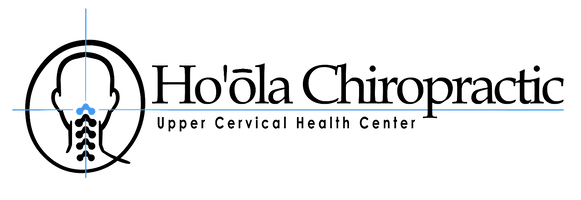Restoring Balance and Relief with Natural Solutions
Meniere’s disease chiropractic care in Honolulu, Hawaii offers patients a unique, non-invasive path to relief from one of the most disruptive inner ear disorders. For those struggling with ringing in the ear, dizziness, aural fullness, or unpredictable hearing loss, the condition can feel overwhelming. Many individuals feel trapped in a cycle of fluid buildup, vertigo attacks, and daily discomfort that affects their quality of life.
The frustration builds when conventional treatment options—like hearing aids, steroid injections, or even surgical shunts—only provide partial relief. Patients often feel discouraged by the persistence of symptoms, the side effects of medications, and the constant uncertainty of when the next attack might occur. This agitation can lead to anxiety, social withdrawal, and even loss of independence.
But there is hope. With specialized chiropractic care, particularly upper cervical chiropractic techniques focused on restoring spinal alignment and reducing nervous system interference, many people experience lasting relief. In Honolulu, patients are finding that targeted chiropractic adjustments and upper cervical care not only help manage symptoms but also support overall spinal health, neurological function, and fluid balance within the inner ear.
Understanding the Nature of Meniere’s Disease
What Makes Meniere’s Disease Different from Other Inner Ear Disorders?
Meniere’s disease is a chronic inner ear disorder often linked to fluid retention and disturbances in the endolymphatic system. Unlike a simple ear infection, this condition affects balance, hearing, and neurological signals connected to the vestibular system. Symptoms often include:
- Sudden or gradual hearing changes
- Persistent ringing in the ear (tinnitus)
- Intense vertigo or spinning sensations
- Pressure in the ear and aural fullness
The inner ear’s semicircular canals and vestibulocochlear nerve play a central role in maintaining equilibrium. When fluid (endolymph) builds up, it disrupts the vestibular nucleus and vestibular nerve signaling, leading to dizziness, nausea, and instability. This explains why patients often describe attacks as disabling.
Why Traditional Treatments May Not Be Enough
Doctors may recommend steroid injections, dietary changes to reduce salt, or even surgical shunts to promote fluid drainage. While these methods sometimes provide temporary relief, they rarely address the root causes. Medications can reduce inner ear pressure but may not correct underlying spinal misalignments or nerve interference linked to symptoms. Patients often report that despite ongoing blood work, MRI scans, or cervical spine radiographs, they continue to struggle with flare-ups.
This is why more patients are turning toward chiropractic treatment, which focuses on the cervical spine, upper neck misalignment, and spinal health as critical factors influencing neurological function and vestibular disorders.
The Role of the Cervical Spine in Inner Ear Function
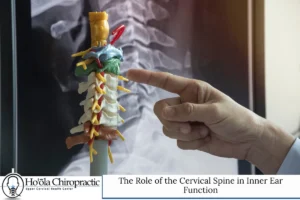
How Spinal Misalignments Affect the Nervous System
The cervical spine, especially the atlas (C1) and axis (C2) vertebrae, plays a critical role in protecting the spinal cord, brain stem, and cranial nerves. When there is vertebral subluxation or cervical spine misalignment, it can disrupt cerebrospinal fluid drainage, blood flow, and communication within the central nervous system.
This interference may contribute to problems like:
- Endolymph buildup and fluid imbalance in the inner ear
- Pressure on the vestibular nerve or trigeminal neuralgia
- Altered sympathetic signals leading to vestibular dysfunction
- Vasogenic edema and circulatory challenges involving the meningeal arteries
Why Upper Cervical Chiropractic Care Stands Out
Upper cervical chiropractic focuses on precise spinal corrections at the craniocervical junction, specifically the atlas vertebrae and axis vertebrae. Small misalignments in these areas can create circular problems, where nerve interference disrupts fluid balance and triggers symptoms of Meniere’s disease.
Through specialized techniques like Blair upper cervical, spinal manipulation, or torque release technique, an upper cervical chiropractor can restore alignment and promote proper cerebrospinal fluid drainage. This approach directly supports the vestibular system, reduces aural fullness, and improves overall neurological function.
Advanced Diagnostics for Meniere’s Disease in Chiropractic Care
Combining Traditional and Chiropractic Evaluations
Accurate diagnosis is essential before starting chiropractic treatment for Meniere’s disease. Many patients first undergo MRI scans, auditory brain stem response tests, and blood work to rule out other vestibular disorders such as benign paroxysmal positional vertigo. While these tests help confirm the condition, chiropractic doctors use additional methods to identify cervical misalignments that may worsen symptoms.
Chiropractic offices in Honolulu often use digital x-rays, cervical spine radiographs, and neurological exams to evaluate spinal health. X-ray imaging of the atlas vertebra and axis vertebrae can reveal subtle spinal misalignments affecting cerebrospinal fluid drainage and vertebral artery blood flow. This precision is what makes upper cervical chiropractic unique—by locating the exact problem, treatment can be carefully tailored.
Looking Beyond the Ear
Although Meniere’s disease is classified as an inner ear disorder, research continues to show links between cervical trauma, vertebrobasilar insufficiency, and dysfunction in the central nervous system. A skilled doctor of chiropractic considers both the ear and the cervical spine, understanding that the vestibular system does not work in isolation. This comprehensive view sets chiropractic apart from treatments focused solely on the ear.
Specialized Chiropractic Treatment Options in Honolulu

Gentle Adjustments for the Upper Cervical Spine
Upper cervical chiropractic care does not rely on forceful spinal manipulation. Instead, it uses precise, gentle adjustments to the atlas (C1) and axis (C2) to restore spinal alignment. These corrections reduce nerve interference at the craniocervical junction, helping normalize vestibular nerve signaling and cerebrospinal fluid flow.
Patients often report improvement in symptoms like:
- Decreased pressure in the ear
- Reduced frequency of vertigo episodes
- Clearer hearing changes
- Less brain fog and fatigue
Beyond Adjustments: Comprehensive Chiropractic Care
While chiropractic adjustment is at the core of treatment, many chiropractors incorporate complementary therapies, including:
- Soft-tissue trigger-point therapy – to release neck tension that may worsen cervical signs.
- Cervical spine rehabilitation exercises – improving stability and posture around the C2-3 joint.
- Vestibular rehabilitation exercises – helping retrain balance and reduce dizziness.
- Dietary changes – minimizing fluid retention and supporting fluid balance in the endolymphatic system.
- Physical therapy integration – supporting body function and reducing muscle pain.
Together, these therapies create a holistic treatment plan that addresses spinal health, neurological function, and fluid drainage in the inner ear.
How Chiropractic Adjustments Influence Inner Ear Function
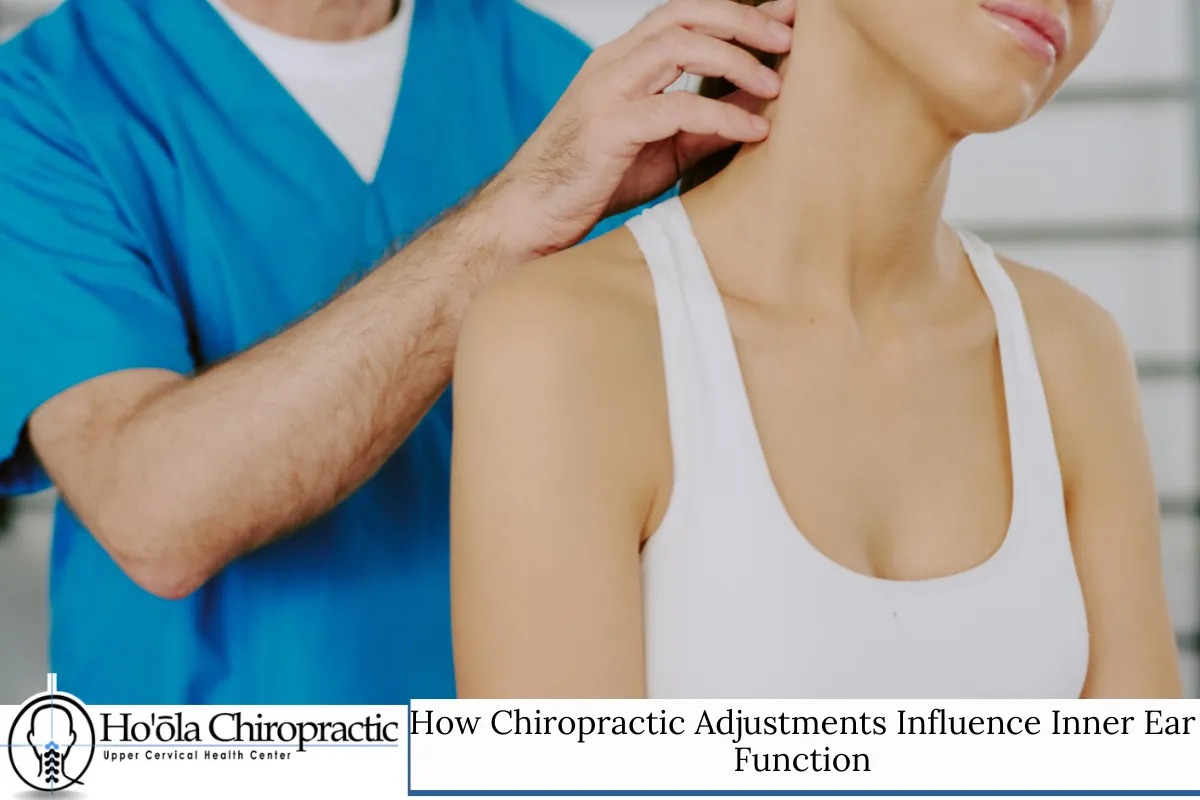
Supporting the Vestibular and Endolymphatic Systems
The vestibular system relies on the proper circulation of fluid (endolymph) and accurate vestibular nerve signaling. When the atlas vertebra or upper cervical spine is misaligned, it can block cerebrospinal fluid drainage and alter blood pressure in the vertebral artery. This interference may cause inner ear pressure and aural fullness.
By correcting spinal misalignments, chiropractic care promotes healthier fluid balance, reduces endolymph buildup, and supports the vestibular nucleus. This explains why many patients experience fewer flare-ups and steadier equilibrium after undergoing upper cervical chiropractic treatment.
Improving Neurological Function
The brain stem, cranial nerves, and spinal cord all depend on optimal spinal alignment to communicate without interruption. Chiropractic adjustments restore balance to the nervous system, reducing sympathetic signals that can disrupt vestibular function. Improved blood flow and reduced nerve interference enhance overall neurological function, often reducing dizziness and tinnitus.
Lifestyle and Complementary Support for Better Outcomes
Practical Home Strategies
A chiropractor may also guide patients with lifestyle adjustments to support their spinal health and reduce vestibular symptoms. Common recommendations include:
- Salt reduction to prevent excess fluid retention.
- Vitamin B-12 supplementation to support neurological health.
- Stress management techniques such as meditation or breathing to reduce cervicogenic headache triggers.
- Proper hydration to assist cerebrospinal fluid balance.
- Sleep posture corrections to avoid unnecessary cervical trauma or tension.
Combining Chiropractic with Other Therapies
In some cases, patients may still use hearing aids, ventilation tubes, or steroid injections for symptom management. A skilled upper cervical chiropractor does not dismiss these tools but works alongside medical providers to ensure a complete treatment plan. The integration of chiropractic treatment with other medical and therapeutic methods creates well-rounded care tailored to patient results.
Patient Results with Upper Cervical Chiropractic in Honolulu
What Patients Commonly Report
Patients who pursue upper cervical care for Meniere’s disease often describe:
- A reduction in vertigo frequency and severity
- Less ringing in the ear and aural fullness
- More consistent hearing changes and stability
- Improved balance and reduced fear of falls
- Better overall quality of life
While individual results vary, consistent upper cervical chiropractic adjustments can make a significant difference for those who previously felt trapped in circular problems with little relief.
Realistic Expectations for Treatment Plans
Chiropractic care is not a quick fix. A treatment plan may include several weeks of spinal corrections, vestibular rehabilitation, and ongoing cervical spine rehabilitation exercises. Patients may undergo follow-up cervical spine radiographs or neurological exams to track progress. Over time, many report steady improvement rather than sudden change, with long-term benefits in spinal health and vestibular stability.
Choosing the Right Upper Cervical Chiropractor in Honolulu
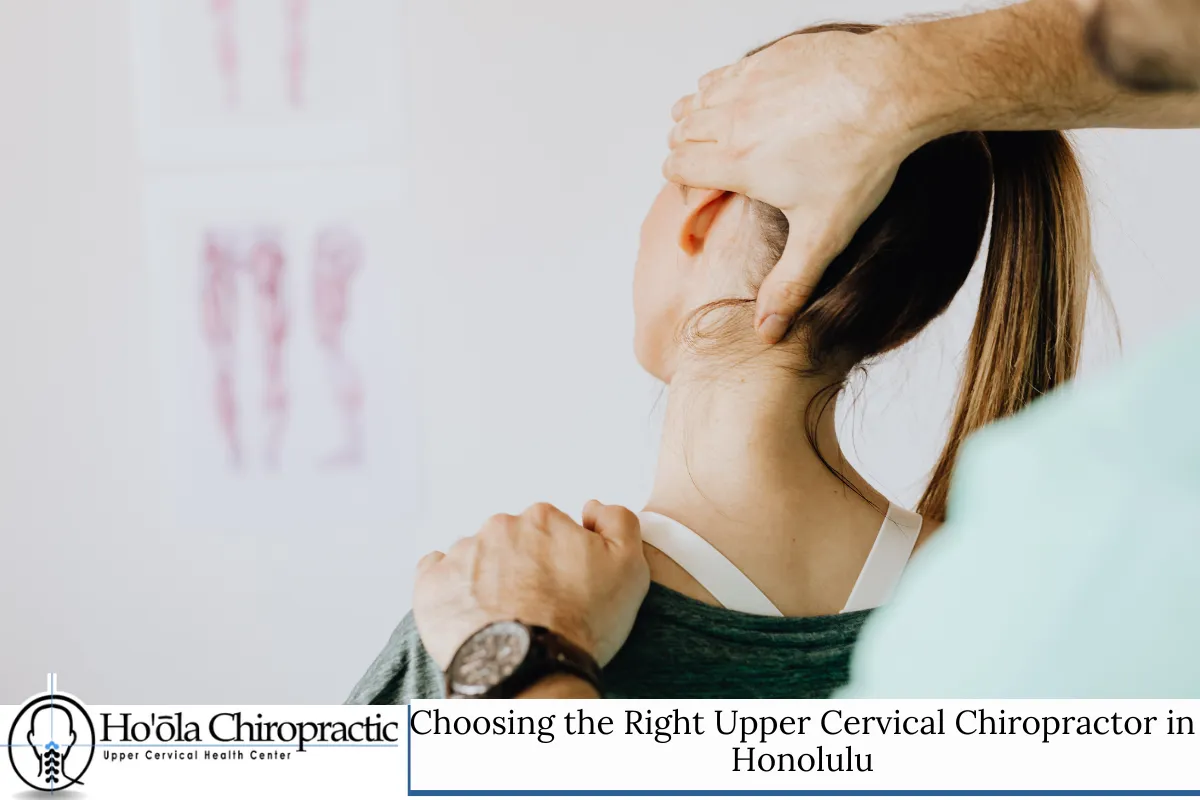
What to Look For in a Provider
When searching for an upper cervical chiropractor in Honolulu, patients should consider:
- Specialized training in upper cervical chiropractic techniques, such as Blair upper cervical or torque release technique.
- Experience with vestibular disorders and knowledge of Meniere’s disease.
- Use of advanced imaging tools like digital x-rays and MRI scans for precise spinal correction.
- Comprehensive treatment plans that integrate chiropractic care with dietary changes, physical therapy, and lifestyle guidance.
- Commitment to patient-centered care with clear communication and supportive follow-up.
Why Honolulu is an Ideal Place for Care
Honolulu offers access to experienced chiropractors trained in specialized techniques, with the added benefit of a healing environment. Many patients find that receiving chiropractic treatment in a location surrounded by natural beauty supports stress reduction, which also contributes to vestibular health.
Finding Lasting Relief with Chiropractic Care
For patients living with Meniere’s disease, the combination of ringing in the ear, inner ear pressure, dizziness, and unpredictable hearing changes can make everyday life exhausting. Traditional treatment options often manage symptoms but leave the root causes unaddressed.
Chiropractic treatment—especially upper cervical chiropractic care—offers a natural, precise, and holistic path to relief. By correcting spinal misalignments, improving cerebrospinal fluid drainage, and supporting neurological function, chiropractic adjustments help restore balance to the vestibular system and endolymphatic system.
Those seeking meniere’s disease chiropractic care in Honolulu, Hawaii, have access to skilled professionals who understand the intricate connections between the cervical spine, nervous system, and inner ear. With specialized techniques, individualized treatment plans, and supportive lifestyle strategies, patients can find new hope and improved quality of life.
Meniere's Disease Chiropractic in Honolulu, Hawaii — Ho'ola Chiropractic
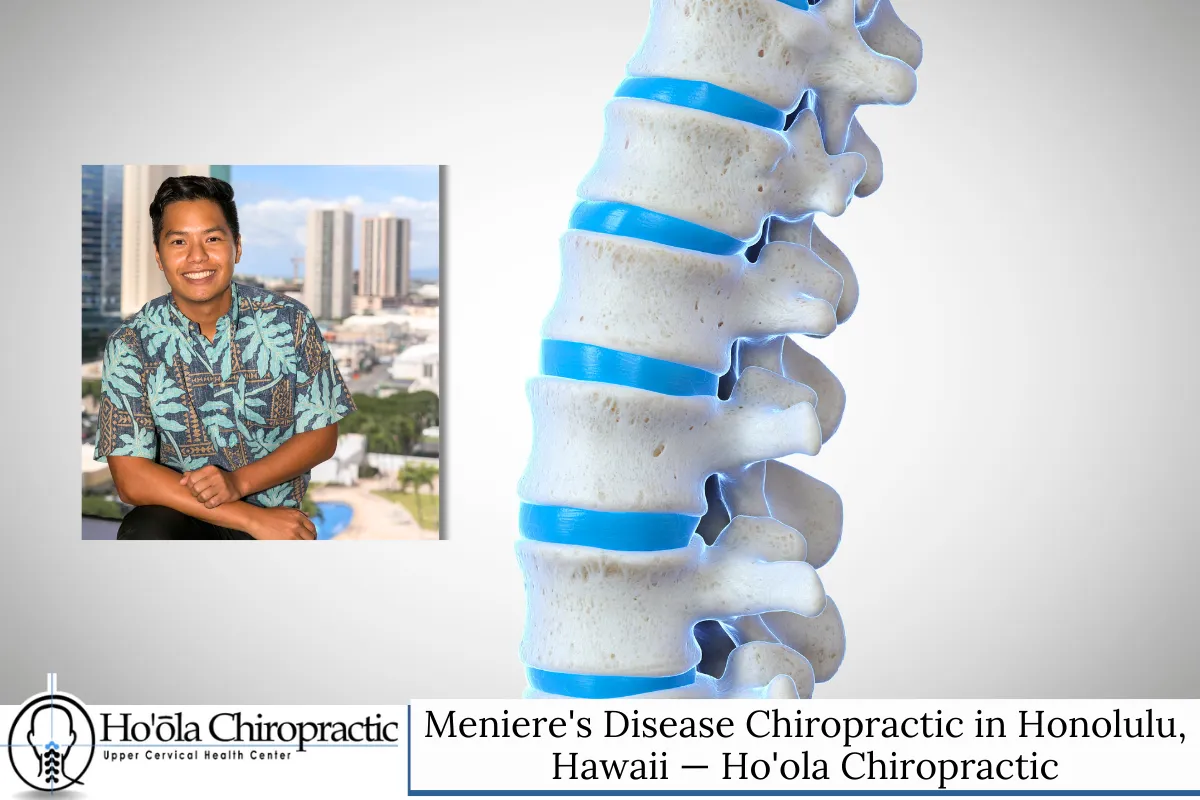
If you’re searching for trusted meniere’s disease chiropractic care in Honolulu, Hawaii, Ho’ola Chiropractic is here to help. Our clinic specializes in gentle upper cervical chiropractic adjustments designed to restore spinal alignment, reduce inner ear pressure, and improve overall nervous system function. Many patients with dizziness, ringing in the ear, or hearing loss have found relief through our personalized treatment plans. Conveniently located in Honolulu and serving surrounding areas, we offer a supportive environment focused on lasting results. Don’t wait to take back control of your health—call us today at (808) 772-8284 or fill out our contact form to schedule your consultation. Experience the difference that upper cervical care can make at Ho’ola Chiropractic.
FAQs About Meniere’s Disease Chiropractic Care
1. How does chiropractic care help with Meniere’s disease?
Chiropractic care focuses on correcting spinal misalignments, particularly in the upper cervical spine where the atlas (C1) and axis (C2) vertebrae are located. When these vertebrae shift out of place, they can affect cerebrospinal fluid drainage, blood flow, and nerve signaling in the brain stem and vestibular system. This disruption may worsen symptoms like dizziness, aural fullness, and ringing in the ear. Through gentle chiropractic adjustments, alignment is restored, which helps improve nervous system communication and reduce pressure in the ear. Over time, many patients experience fewer vertigo episodes, clearer hearing, and improved balance without relying solely on medications or invasive procedures.
2. Is upper cervical chiropractic safe for treating inner ear disorders?
Yes, upper cervical chiropractic is considered safe when performed by a licensed and experienced chiropractor. Unlike forceful spinal manipulation, upper cervical adjustments are precise and gentle, targeting only the atlas and axis vertebrae. These corrections restore balance at the craniocervical junction, reducing nerve interference and supporting healthy vestibular function. Safety is enhanced by thorough diagnostic evaluations, including digital x-rays or MRI scans, before starting treatment. Most patients report little to no discomfort during the procedure. While every medical treatment carries some risk, the non-invasive nature of upper cervical care makes it a safe option for individuals with Meniere’s disease compared to more aggressive interventions such as surgical shunts or steroid injections.
3. Can chiropractic treatment replace hearing aids or medical treatments?
Chiropractic treatment does not replace hearing aids or all medical treatments, but it can complement them. For some patients, restoring spinal alignment and improving cerebrospinal fluid flow reduces the severity of hearing changes and ringing in the ear. However, if permanent damage has occurred to the inner ear or vestibulocochlear nerve, a hearing aid may still be necessary. Chiropractic care primarily addresses the underlying neurological and circulatory components that influence inner ear pressure and vestibular disorders. Ideally, patients should view upper cervical chiropractic as part of a comprehensive treatment plan that may also include dietary changes, medical monitoring, or physical therapy. Collaboration between chiropractors and medical professionals often provides the best results.
4. How long does it take to notice results from chiropractic adjustments?
The timeline for results varies from patient to patient. Some individuals report improvement in symptoms like dizziness or aural fullness after just a few chiropractic adjustments, while others require several weeks of consistent care. This difference often depends on the severity of cervical misalignment, the extent of fluid buildup in the inner ear, and the patient’s overall health. A treatment plan may include frequent visits during the first few weeks, followed by maintenance sessions once spinal correction is stabilized. Long-term benefits usually come with consistent care, lifestyle changes such as dietary adjustments, and adherence to rehabilitation exercises. Patience is important, as Meniere’s disease is a chronic condition that responds gradually to natural therapies.
5. What makes Ho’ola Chiropractic different from other clinics in Honolulu?
Ho’ola Chiropractic stands out because of our focus on upper cervical chiropractic care—a specialized approach designed to correct subtle misalignments in the atlas and axis vertebrae. Unlike general chiropractic practices that may emphasize full-spine adjustments, we use gentle, targeted techniques backed by advanced imaging to ensure precision. Our clinic also integrates lifestyle guidance, including dietary changes and vestibular rehabilitation exercises, to support lasting results. Located in Honolulu and serving nearby areas, we provide personalized care tailored to each patient’s unique condition. Patients appreciate our combination of expertise, compassion, and commitment to helping those struggling with Meniere’s disease find real relief and a path back to balance.
Read Understanding Meniere’s Disease Chiropractic Care in Honolulu, Hawaii
